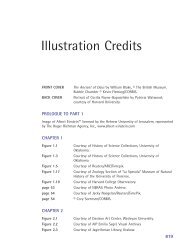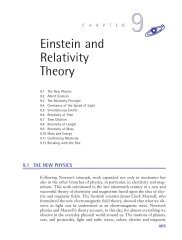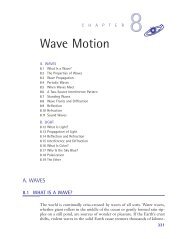Chapter 12: Electromagnetic Waves (545 KB) - D Cassidy Books
Chapter 12: Electromagnetic Waves (545 KB) - D Cassidy Books
Chapter 12: Electromagnetic Waves (545 KB) - D Cassidy Books
You also want an ePaper? Increase the reach of your titles
YUMPU automatically turns print PDFs into web optimized ePapers that Google loves.
3637_<strong>Cassidy</strong>TX_<strong>12</strong> 6/13/02 11:34 AM Page 565<strong>12</strong>.5 THE ELECTROMAGNETIC SPECTRUM 565centered around a single radio transmitter. A cellphone is technically a cellularradio transceiver, since it receives and sends radio signals.In December 1901, the Italian inventor Guglielmo Marconi successfullydetected radio waves sent from Newfoundland to Ireland. Marconi’s work,perfected later on Cape Cod, Massachusetts, showed that long-distance radiocommunication was possible, because the waves were reflected by thepreviously unsuspected layers of ionized particles in the upper atmosphereand therefore could be received at great distances despite the curvature ofthe Earth’s surface.Radio communication is accomplished by changing the signal accordingto an agreed code that can be deciphered at the receiving end. The firstradio communication was achieved by turning the signal on and off in anagreed pattern, such as Morse code (which is recognized today as a digitalcode). Later, sounds were coded by continuous variations in the amplitude(i.e., the intensity) of the broadcast wave. This is known as amplitude modulation,or AM. Later still, the information was coded as frequency variationsin the broadcast wave, known as frequency modulation, or FM. Inbroadcast radio and television, the “decoding” is done in the receiver servingthe loudspeaker or TV monitor, since the output message from the receivertakes the same form that it had at the transmitter. Radio stations regularlyannounce their frequencies in megahertz (MHz) for the FM bandand kilohertz (kHz) for the AM band.Because signals from different radio stations should not be received atthe same spot on the dial, it is necessary to apportion the allowed frequenciesof transmission within a region covered by radio signals. The InternationalTelecommunication Union (ITU) controls radio transmissionand other means of international communication. Within the United States,the Federal Communications Commission (FCC) regulates radio transmission.In order to reduce the interference of one station’s signal with another,the FCC assigns suitable frequencies to radio stations (and otherFIGURE <strong>12</strong>.10 Radio wavesbouncing off the ionosphere.






